| Author |
Message |
M. Eversberg II

|
 Posted: Fri 14 Aug, 2009 6:15 pm Post subject: Posted: Fri 14 Aug, 2009 6:15 pm Post subject: |
 |
|
Any local hobby shop is bound to have brass sheeting.
M.
This space for rent or lease.
|
|
      |
 |
|
Luke Zechman
Location: Lock Haven Pennsylvania Joined: 18 Jan 2009
Posts: 278
|
 Posted: Mon 09 Nov, 2009 8:49 am Post subject: Posted: Mon 09 Nov, 2009 8:49 am Post subject: |
 |
|
This project has been on the back burn for about two months now, because of school and work being my main focus. I have had some time here and there to work on the brass cross guard that will be recessed into the face of the hilt assembly. My question is this... How snug does the cross guard need to fit onto the tang? Somewhere in my file work I had removed just a tad too much material. The blade sits nicely against the cross, but there is just a little bit of play side to side. I figure with it being recessed into the wooden part of the cross that it will not be too important, but just checking. I want to do this right. If I have to I will redo the whole piece from scratch even though it has been relatively time consuming.
Another question I had was... Did the Romans use leather washers between hilt components? If so, how long does something like this last, before it must be replaced?
Thanks in advance for any help, and I hope to have this project done over Christmas break.
|
|
  |
 |
Sean Flynt

|
 Posted: Mon 09 Nov, 2009 9:56 am Post subject: Posted: Mon 09 Nov, 2009 9:56 am Post subject: |
 |
|
If the hole in the brass piece is just slightly too large, you can probably close it enough by putting it on a hard surface (anvil) and striking around the edge of the hole with a hammer (glancing blows directed toward the middle of the hole). You can clean it up with files as needed. It's a good idea to use JB Weld or similar epoxy for assembly, too.
I don't know about the Romans, but I think leather washers are a bad idea. I can't think of any reason for them and the leather would dry out and shrink over time, leaving you with ill-fitting hilt furniture.
-Sean
Author of the Little Hammer novel
https://www.amazon.com/Little-Hammer-Sean-Flynt/dp/B08XN7HZ82/ref=sr_1_1?dchild=1&keywords=little+hammer+book&qid=1627482034&sr=8-1
|
|
   |
 |
|
Matthew Amt
|
 Posted: Tue 10 Nov, 2009 7:18 am Post subject: Posted: Tue 10 Nov, 2009 7:18 am Post subject: |
 |
|
Ah, progress! I don't think the guard has to be super-tight--once you peen the tang down, it should all be firm enough. But you can stick a couple wood shims in the hole if you like. Toothpicks may work.
There is no evidence for leather washers that I've ever seen. There's no real need for them.
Keep at it!
Matthew
|
|
   |
 |
|
Luke Zechman
Location: Lock Haven Pennsylvania Joined: 18 Jan 2009
Posts: 278
|
 Posted: Tue 10 Nov, 2009 8:23 am Post subject: Posted: Tue 10 Nov, 2009 8:23 am Post subject: |
 |
|
Thank you for the replies gentlemen. I will have time over Thanksgiving break, and it should be enough time to finish the work. Its pretty bad when I have to be focused on school and I am sitting in my Cellular Molecular Biology class day dreaming about weapons. 
The hammer shaping did in deed make the hole significantly smaller, and refinishing was not a hassle at all. I did however start a whole new cross from the other side of the hinge I cut the original from. I probably didn't have too but practice make perfect, and well if I didn't enjoy doing this in the first place I wouldn't be.
Just need to get some sugar maple off of a friends wood pile, and pick up the right leg bone from a local slaughter house and I should have everything I need to finish. I have some hornbeam and hickory that is cured, but wanted to use something more historical.
At this point I am very antsy to have a solid handle for a blade that has really grown on me. Not the finest blade in the world, but I really like its character. I can't wait to finish this and post some pictures.
|
|
  |
 |
|
Mark Millman
|
 Posted: Tue 10 Nov, 2009 1:34 pm Post subject: Posted: Tue 10 Nov, 2009 1:34 pm Post subject: |
 |
|
Dear Mr. Zechman,
| On Tuesday 10 November 2009, you wrote: | | . . . Just need to get some sugar maple off of a friends wood pile, and pick up the right leg bone from a local slaughter house and I should have everything I need to finish. I have some hornbeam and hickory that is cured, but wanted to use something more historical. . . . |
I'm sorry to have to tell you this, but sugar maple is a specifically North American species. In the sense that both sugar maples and American hornbeams have close European relatives, they're equally appropriate; and as maple is an attested wood for a surviving artifact, you may prefer it. But that maple is certainly a European species, which the sugar maple is not. Norway maple, which is a common introduced species in the U.S., is native to Europe and grows in southern France and northern and western Italy. It would be a good choice for a historically-plausible wood, since you seem to want to pursue that level of detail--for which I commend you.
I hope that this proves helpful.
Best,
Mark Millman
|
|
  |
 |
|
Luke Zechman
Location: Lock Haven Pennsylvania Joined: 18 Jan 2009
Posts: 278
|
 Posted: Tue 10 Nov, 2009 6:39 pm Post subject: Posted: Tue 10 Nov, 2009 6:39 pm Post subject: |
 |
|
|
My train of thought was that maple (sugar or introduced) would be more historically accurate then hornbeam or hickory. I knew for certain (without consulting my botany text) maple species also grow in Europe. I was unaware that anything like either hickory or hornbeam grow in Europe so I opted them out even though I have a few beautiful pieces in my shop. Hickory is out for sure since it is only native to N.America Canada and Mexico, even though I love working it. Hornbeam / Muscle wood is however (after a quick internet query) represented by European counterparts which are of the same Genus (very closely related.) This is good news and I thank you for bringing this to my attention. I have been looking for a reason to work the Hornbeam, although I fear I may regret it later. (that stuff is hard) [/i]Carpus caroliniana it is!! This wood as I understand it is very light, and so in combination with a bone grip might make for an atypical and possibly interesting look for a gladi. Most of the modern productions you see include a dark pommel and cross, with a light either holly or bone looking handle. Thank you Mark!!!
|
|
  |
 |
|
Luke Zechman
Location: Lock Haven Pennsylvania Joined: 18 Jan 2009
Posts: 278
|
 Posted: Sat 14 Nov, 2009 1:11 pm Post subject: Posted: Sat 14 Nov, 2009 1:11 pm Post subject: |
 |
|
I have once again change my mind about the wood. The piece of hornbeam that I have is not cured yet. I underestimated how long this would take. The piece is about 2 feet long and about 5in in diameter. It was only cut about a year and a half ago, which in the language of super hard Hornbeam equals too high of a moisture content as of yet I cut off the end of the piece past where it had split, and by the next morning the end was splitting. Any advice on wood and curing would be appreciated. I went ahead and ordered a block (8X8X3) of Walnut online. I know Walnut has never been documented historically, but I hear it is "a nice wood to work" (Matthew Amt Legio XX Website. Very helpful site by the way). The wood should be here by Tuesday! Also I should be able to get enough wood out of that block to do three or four more gladii.
The second thing is that i finished the brass cross guard ( the second one I had made for this project), and it fits very well without any side to side movement. I discovered part of the problem which was that the tang was actually thicker somewhere in the middle. In order to get past it you would have to make the hole larger then where it will finally rest. I tapered the tang and took it very slow with material removal until the blade sat nicely against the cross. GO SLOW LUKE!!!! I get too excited sometimes. 
Here are some pictures of crosses. Also a picture of the fit on the tang.
The new cross is closer to my fingers.
 Attachment: 28.21 KB Attachment: 28.21 KB
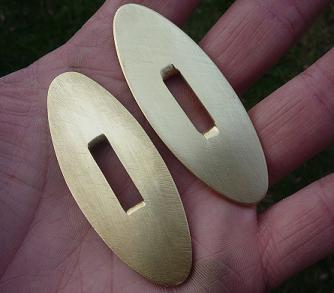
 Attachment: 25.25 KB Attachment: 25.25 KB
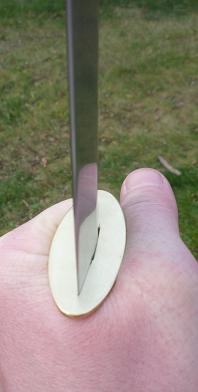
|
|
  |
 |
|
Ken Speed
|
 Posted: Sat 14 Nov, 2009 2:13 pm Post subject: Posted: Sat 14 Nov, 2009 2:13 pm Post subject: |
 |
|
Luke,
Nice fit on the tang, good job. You might want to consider wearing a dust mask when you're working the walnut, some people have pretty violent allergic reactions to walnut wood dust.
Ken
|
|
  |
 |
|
Mark Millman
|
 Posted: Sat 14 Nov, 2009 7:55 pm Post subject: Posted: Sat 14 Nov, 2009 7:55 pm Post subject: |
 |
|
Dear Luke,
| On Tuesday 10 November 2009, you wrote: | | . . . I have been looking for a reason to work the Hornbeam, although I fear I may regret it later. (that stuff is hard) Carpus caroliniana it is!! This wood as I understand it is very light, and so in combination with a bone grip might make for an atypical and possibly interesting look for a gladi. Most of the modern productions you see include a dark pommel and cross, with a light either holly or bone looking handle. Thank you Mark!!! |
You're very welcome, and I'm sorry to hear that the hornbeam didn't work out. Perhaps on your next gladius project you'll be able to use both the first guard-plate and the hornbeam.
There are surviving examples of gladii mounted entirely--guard, grip, and pommel--with bone and with ivory, not to mention a silver-covered hilt or two, so an all-light appearance wouldn't be unheard-of. In fact, the use of dark woods, particularly walnut, for the guard and pommel seems to be a bit of a re-enactorism, probably because of its appeal to modern aesthetics. The Romans don't seem to have gone to any particular effort to make their guards and pommels contrast with their grips; on the other hand, there also doesn't seem to be evidence that they went to great lengths to avoid it. And certainly oiled wood will darken over time, while bone will stay pretty white. My guess is that the Romans used whatever local woods were available, inexpensive, and had the necessary combination of durability and workability to make good hilt parts. (There is, by the way, a good reason to use bone for grips if it's available: Like ivory, it resists becoming slippery when wet.)
| And on Saturday 14 November 2009, you also wrote: | | . . . I went ahead and ordered a block (8X8X3) of Walnut online. I know Walnut has never been documented historically, but I hear it is "a nice wood to work" (Matthew Amt Legio XX Website. Very helpful site by the way). . . . |
The walnut definitely will look good on your sword. I have heard, but don't know from experience, that American walnuts have darker wood than European ones, but I don't think that's a big issue. As I mention above, all woods darken with repeated oiling over time, so I don't think it's unreasonable to have a pretty dark walnut in the hilt.
I look forward to seeing the gladius when you've finished it.
Best,
Mark
|
|
  |
 |
|
Luke Zechman
Location: Lock Haven Pennsylvania Joined: 18 Jan 2009
Posts: 278
|
 Posted: Tue 17 Nov, 2009 8:47 pm Post subject: Posted: Tue 17 Nov, 2009 8:47 pm Post subject: |
 |
|
Ok here is a quick mock up of the wooden portion of the cross. The block of Walnut I received is beautiful, and i cut a rectangular chunk off of the corner of it for the cross. A sureform made quick work of it, and yet it feels plenty hard. After a good soaking in my linseed tank it should get even harder and obviously much darker. The brass piece will be countersunk into the face I am very pleased with the overall shape of this part and can only see minor things that have to be tweaked. Now I just need to be very careful when cutting out for the brass, and try not to blemish the rim. Maybe I should have cut out for the brass piece before I shaped the body of the cross. I have a feeling it will be a lot harder shape the pommel to be close to my original plan
Just added the picture of the fitted cross guard. I took a chance and hand drilled the hole out for the tang. I can't believe how dark the walnut got after sitting in linseed oil overnight. I think I will place some shims in between the wood and the tang to make things even more secure when fully assembled.
 Attachment: 26.85 KB Attachment: 26.85 KB
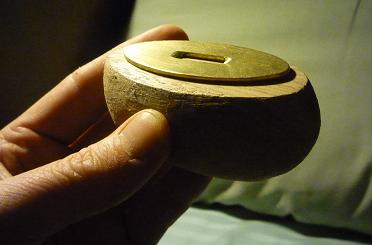
 Attachment: 27.97 KB Attachment: 27.97 KB
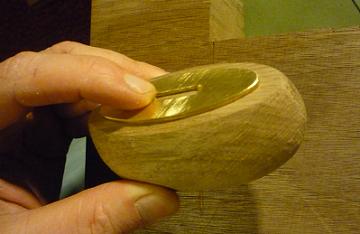
 Attachment: 24.19 KB Attachment: 24.19 KB
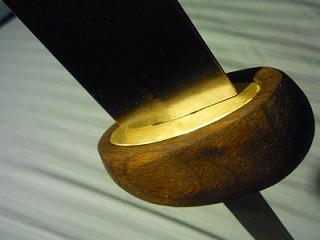
|
|
  |
 |
Maurizio D'Angelo

|
 Posted: Thu 19 Nov, 2009 5:07 am Post subject: Posted: Thu 19 Nov, 2009 5:07 am Post subject: |
 |
|
Is a beautiful vision, good work.
A tip: for the grip, bone of cow tends to be fragile for combat can be a problem.
Bone giraffe is very tough and elastic. Perhaps less historic, but very functional.
The difference is not seen, the color is equal. I hope this helps.
 Attachment: 64.24 KB Attachment: 64.24 KB
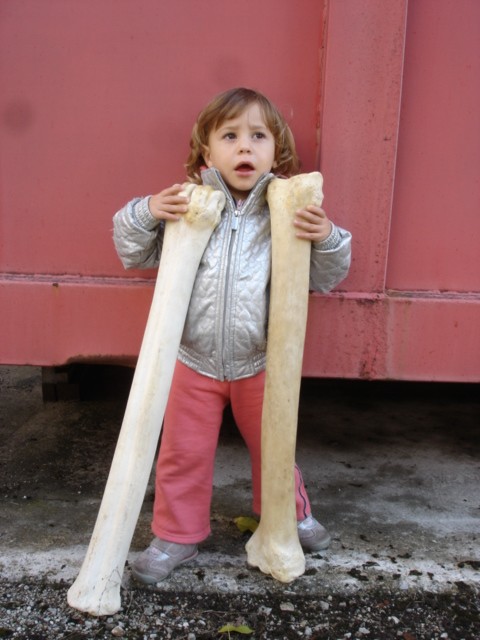
 Attachment: 40.96 KB Attachment: 40.96 KB
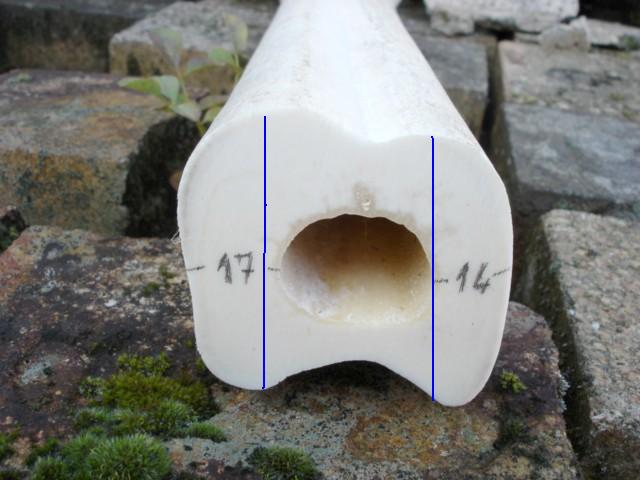
|
|
   |
 |
Luka Borscak

|
 Posted: Thu 19 Nov, 2009 5:16 am Post subject: Posted: Thu 19 Nov, 2009 5:16 am Post subject: |
 |
|
Cool picture with your daughter. 
Btw, giraffe bone might even be historically plausible for a Roman sword...
|
|
  |
 |
Maurizio D'Angelo

|
 Posted: Thu 19 Nov, 2009 5:23 am Post subject: Posted: Thu 19 Nov, 2009 5:23 am Post subject: |
 |
|
| Luka Borscak wrote: | Cool picture with your daughter. 
Btw, giraffe bone might even be historically plausible for a Roman sword... |
not my daughter, he is a great warrior.
I agree it is plausible, but I think the most common bone of cow.
Ciao
Maurizio
|
|
   |
 |
Luka Borscak

|
 Posted: Thu 19 Nov, 2009 6:20 am Post subject: Posted: Thu 19 Nov, 2009 6:20 am Post subject: |
 |
|
Sorry, the pink color fooled me. 
|
|
  |
 |
|
Ben Sweet
|
 Posted: Thu 19 Nov, 2009 12:29 pm Post subject: Posted: Thu 19 Nov, 2009 12:29 pm Post subject: |
 |
|
Very nice...and I envy your Dremel skill, that is one tool I just can not hold still with out it going zooming off in not the wrong direction 
|
|
   |
 |
|
Luke Zechman
Location: Lock Haven Pennsylvania Joined: 18 Jan 2009
Posts: 278
|
 Posted: Mon 23 Nov, 2009 3:37 pm Post subject: Posted: Mon 23 Nov, 2009 3:37 pm Post subject: |
 |
|
Fellow Forumites,
I stopped by the local pet store today on a whim, with the hopes of finding a suitable bone for the grip. This was the same store I had check several months ago for bones of the right size without any luck. I found a very suitable bone for this project and have been neglecting my microbiology homework for the past three hours to shape it!  I have stuck to my original hexagonal cross section. This is the first time I have tried my hand at carving bone, and I will admit the smell will take some getting used to. Also my dog will not stop giving me the stinky eyeball from across the room... he is very confused as to what I am doing, and must be wondering why I have not relinquished this stinky bone. I have stuck to my original hexagonal cross section. This is the first time I have tried my hand at carving bone, and I will admit the smell will take some getting used to. Also my dog will not stop giving me the stinky eyeball from across the room... he is very confused as to what I am doing, and must be wondering why I have not relinquished this stinky bone.
Other developments include the crafting of a completely different wooden cross. I had gotten impatient again and ended up taking a huge chunk off the rim around inset brass part. I was very mad! The new cross is more refined, less clunky and has a more elegant look and feel. it is soking in the linseed oil tank right now and have very beautiful grain and color. (I really like that walnut I bought) In addition to the new improved shape, the inset portion has been done much better this time around. The brass piece actually sits down in the wood and is about 1mm from the top plain.
In all this project is a delight. I am learning so much. Thanks for all the comments.
Maurizio,
Thanks for the advice on the giraffe bone. The only problem is that I don't know where to get giraffe bone and was a little reluctant to in the first place as giraffes are not as common as cows. After working this material for three hours I cannot imagine it will be to fragile in any way. It makes sense that a giraffe has denser bone being that they are so adapted for outstanding height. and a heavier animal in general. Also i can imagine that giraffe bone might be accurate since the Romans had a lust for exotic animals. That picture of your son is very cute!
Ken thanks for the nice comment. I have worked on potters wheels and that take a lot of rock solid steadiness. Perhaps that is where I get it from.
Anyways here are some pic of the grip in progress.
 Attachment: 32.08 KB Attachment: 32.08 KB
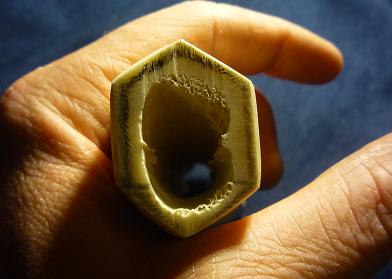
 Attachment: 22.67 KB Attachment: 22.67 KB
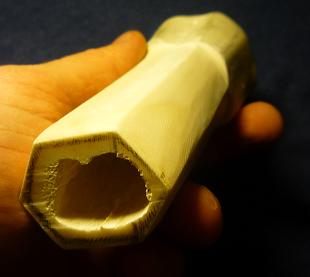
|
|
  |
 |
|
Ken Speed
|
 Posted: Mon 23 Nov, 2009 3:48 pm Post subject: Posted: Mon 23 Nov, 2009 3:48 pm Post subject: |
 |
|
From Luke's comments about working bone and a friend's comments about the horrific stink involved in making a horn knife handle I think I'll stick with wood. I am, however, curious; what does one use to fill the cavity in the bone where the marrow used to be?
Ken
|
|
  |
 |
|
Luke Zechman
Location: Lock Haven Pennsylvania Joined: 18 Jan 2009
Posts: 278
|
 Posted: Mon 23 Nov, 2009 4:07 pm Post subject: Posted: Mon 23 Nov, 2009 4:07 pm Post subject: |
 |
|
|
As of right now the tang does not fit inside the bone. Also you will notice that the hole is a little offset. when I get in there and work the inside with a round double cut file I will remove material from the thick side. I will do this slowly and with care until the fit is tight. When i do the final assembly I will wedge the grip into place with either wood or scrap pieces of brass left over from the hinge I cut the cross from. I was also thinking of cutting a small recess into the cross and pommel to secure the grip where I want it but I want to find out if this is historical first. I feel that with some wedges and the tang being peened that the grip won't be going anywhere. If anyone has any advice as to how to do this securely then let me know... Thanks all!
|
|
  |
 |
|
Hadrian Coffin
Industry Professional
Location: Oxford, England Joined: 03 Apr 2008
Posts: 404
|
 Posted: Mon 23 Nov, 2009 4:50 pm Post subject: Posted: Mon 23 Nov, 2009 4:50 pm Post subject: |
 |
|
I would advise getting a decent respirator, bone dust can do nasty things to your lungs!
Historia magistra vitae est
|
|
   |
 |
|
|
You cannot post new topics in this forum
You cannot reply to topics in this forum
You cannot edit your posts in this forum
You cannot delete your posts in this forum
You cannot vote in polls in this forum
You cannot attach files in this forum
You can download files in this forum
|
All contents © Copyright 2003-2024 myArmoury.com — All rights reserved
Discussion forums powered by phpBB © The phpBB Group
Switch to the Basic Low-bandwidth Version of the forum
|

